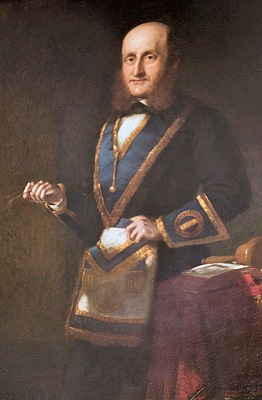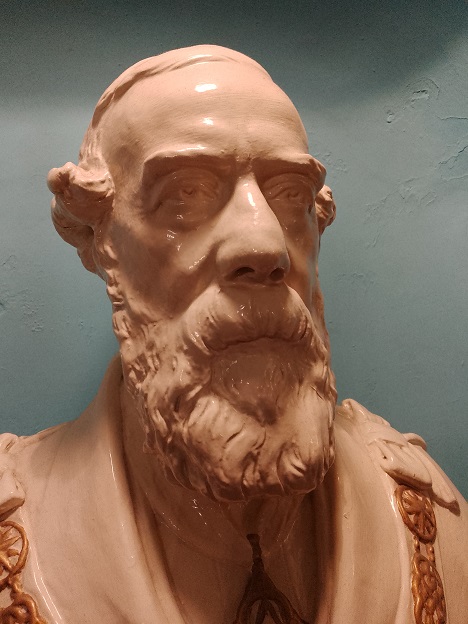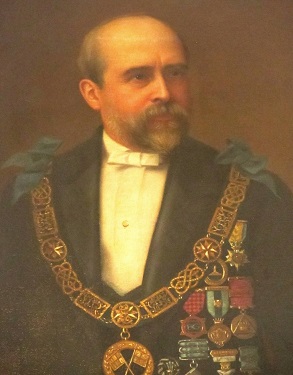Is there a Doctor in the House?
 1849 became known as "The Summer of Horror" as cholera spread through Hull claiming over 1,860 victims. The Rev James Sibree, Chaplain to Hull General Cemetery recorded that on one occasion he had performed forty-three funeral services in one day. He wrote that "double graves were constructed in which coffins were piled on top of one another without any earth between them." Cholera was epidemic through the world, possibly originating in India, reaching Asia, Europe, North Africa and Russia through shipping. John Snow's research and discoveries identifying inadequate sanitation as the cause came to influence public health and a breakthrough in epidemiology.
1849 became known as "The Summer of Horror" as cholera spread through Hull claiming over 1,860 victims. The Rev James Sibree, Chaplain to Hull General Cemetery recorded that on one occasion he had performed forty-three funeral services in one day. He wrote that "double graves were constructed in which coffins were piled on top of one another without any earth between them." Cholera was epidemic through the world, possibly originating in India, reaching Asia, Europe, North Africa and Russia through shipping. John Snow's research and discoveries identifying inadequate sanitation as the cause came to influence public health and a breakthrough in epidemiology.
Medical science was improving rapidly in the nineteenth century; in Great Britain between 1801 and 1850 over eight thousand university educated men entered the profession, more than in all previous history, and hospital facilities were improving, providing more room for patients and opportunities for the training of doctors. Studies were made in medical anatomy, physiology and pharmacy. (Gray's Anatomy was first published in 1858.) The discovery of morphine, quinine, atropine, digitalin, iodine and codeine added much to medical knowledge, but in actual practice not a great deal was achieved regarding the population as a whole.
In Hull, it was the local doctors and sanitary reformers who diagnosed the problems which had been overlooked (perhaps deliberately) in an inquiry made in 1844. They formed a sanitary committee outlining the difficulties caused by the geographical situation of the town, the low-lying ground and the drains flowing into the River Hull (which is tidal in the lower reaches. The committee's reports had little effect at the time, for the recommended precautions were largely disregarded and the poorer part of the population was dying at the highest rate in the country - in the first three weeks of September 1840 more than five hundred folk were dying weekly.
As far as the Minerva Lodge was concerned, "by the year 1856 there was a real turn in the tide and flow of prosperity when Brother Arthur Octavius Arden was installed as WM." [Ellerby] Arden was a surgeon, and he and his successor to the Chair, Simeon Mosely managed to turn things round. Barry Hovell tells us "Dr Arden was credited with reorganising the Minerva Lodge, putting on a sound footing and making it more attractive. He unfortunately died aged thirty-nine at the height of his powers and was a great loss to the Lodge." Arden instituted the Benevolent Fund of the Lodge and raised some £800 for local charities such as the Infirmary, cotton mill operatives and the artillery.

Simeon Moseley was a Surgeon Dentist in Whitefriargate, and invented a palate for false teeth "And for which HER MAJESTY has granted him her ROYAL LETTERS PATENT" reads an advertisment in the local paper, The Hull Packet in 1854. He was WM in 1857 and 1858. He also became the Primus Master of Kingston Lodge 1010 in 1864. He died in 1888, totally impoverished, the result of a dispute with his sister.) He was the first Minerva to have his portrait painted and presented to the Lodge (1861.) The artist, George Pycock-Green, also painted the fine portrait of Queen Victoria which hangs in Hull City Hall.
Neil Armstrong, notable Masonic researcher and local historian (and part of the Operating Theatre Team at CHH before he retired) sent me an email regarding Simeon Moseley's contested claim for his invention, which adds an interesting sideline to the above:
In 1854 Simeon Mosely patented a means of manufacturing artificial palates for the adaption of false teeth. John Wainwright, a single-handed dentist practising in Birkenhead also claimed the rights to this invention. (I have checked with the Patents Office and the only patent to John Wainwright was for shop-fronts! In fact shortly afterwards Wainwright was himself charged with throwing acid over an unfortunate female in a public street. He was sentenced to twenty years and died in prison. His deranged mental state was probably the result of the now well documented effects of inhaling dental anaesthetic vapours (anaesthesia was still in its infancy) to ascertain their identity and strength. This was a disconcerting habit of early doctors and dentists, which was still in use up to the late 1970’s (I witnessed many older anaesthetists doing this!) Addiction could easily result.
A funeral oration by Bro Michael Charles Peck (see later) delivered fifteen days after Mosely's death in 1888 lamented "Once again, my Brethren, has the arrow of our mortal enemy been dispatched on its dread mission, and another of Minerva's greatest Masters has fallen beneath the blow . . . now our ranks are again broken by the death of our Senior Past Master, Bro Simeon Mosely, who was once the leading spirit and shining light in this Lodge . . . When our worthy Brother was in his glory, his means were ample, his heart geneous and his liberality and hospitality unbounded . . .Nor were his labours confined to the Craft, but in Royal Arch Masonry he was equally, even if not still more successful. He was elected to the chair of First Principal in 1859 and again in 1863. Here his knowledge of the Hebrew language, and his majestic style, invested the ceremonial with a dignity and grndeur which few have equalled - none excelled . . . the Lodge elected him as one of its Trustees as well as of its Benevolent and Building funds . . . A consistent Member of his ancient nation, he was President of the Hull Hebrew Congregation for many years . . . [he] took a conspicuous part in our local history, having been a Captain of the Artillery Corps, a member oif the Town Council, of the Microscopical Society, the Literary and Philosophical Society and was identified with nearly every public Institution in the Town."


Doctor John Pearson Bell had been WM of the Humber Lodge in 1841 and 1842 and was a well respected figure in Hull. He was elected an honourary member of the Minerva Lodge in 1856. and his immediate interest in its progress were of great value in restoring the Lodge's fortunes. Bell acted as Lecture Master and Installing Officer and became MEZ of the Minerva Chapter. He relinquished his Provincial post as Grand Secretary awarded in 1860 to become Deputy Provincial Grand Master in 1866. His funeral was attended by three hundred Masons in regalia. There is a painting of Bell in his Royal Arch Robes at Dagger Lane and a bust of him in the Lodge Room.

In 1861 Bro James Henderson retired as Tyler after a quarter century in that position. The Lodge granted him a pension from the Benevolent Fund of £12 per annum, but he did not live long enough to enjoy it.
The portrait of another notable character hangs at Dagger Lane, that of Michael Charles Peck, P.M, Grand Standard Bearer of England, PSPGW & Prov Grand Sec. Treasurer of the Minerva Lodge, the writer of the Oration on Mosely's death, of which fragments appear earlier on this page. Ellerby writes:
 In 1859 on the 9th February there was initiated another brother who was to become one of the stalwarts of the lodge in Brother Michael Charles Peck Jnr., whose long and valuable ervice to the Order deserves the greatest possible credit. He was but twenty-one years of age at his initiation, and within two years had become Secretary of the Lodge, which post he held for twenty-six years, followed by a further eleven years as Treasurer. For some reason which has never been explained he never became Master of the Lodge, but when the Sykes Lodge No. 1040 at Driffield was formed on the 1st December 1864 he became its first Master, and two years later, being then but twenty-eight years of age, on the resignation of Dr J P Bell from the office of Provincial Grand Secretary, Bro Peck was appointed to that office which he held for the next forty years.
In 1859 on the 9th February there was initiated another brother who was to become one of the stalwarts of the lodge in Brother Michael Charles Peck Jnr., whose long and valuable ervice to the Order deserves the greatest possible credit. He was but twenty-one years of age at his initiation, and within two years had become Secretary of the Lodge, which post he held for twenty-six years, followed by a further eleven years as Treasurer. For some reason which has never been explained he never became Master of the Lodge, but when the Sykes Lodge No. 1040 at Driffield was formed on the 1st December 1864 he became its first Master, and two years later, being then but twenty-eight years of age, on the resignation of Dr J P Bell from the office of Provincial Grand Secretary, Bro Peck was appointed to that office which he held for the next forty years.
He must have been an ideal Secretary for his minutes are models of perfection, being exceedingly well expressed and beautifully writeen. He was considered an authority on all masonic matters and was the leading spirit in all the higher degrees, viz: Royal Arch, Mark, Knights Templar, Rose Croix, and a principal founder and first Master of the Humber Installed Masters Lodge No. 294.
In November 1863 the Minerva Hall, after being entirely renovated, reconsecrated with full ceremonies. The place had been let out for private functions, including Amateur Performances, which must have been a valuable source of income as well as entertainment. (This was obviously a U turn from the decision made in 1817 when it was decided "This Lodge having long ago decided not to sanction any Theatrical proceedings" when Bro Chas Wood, a Comedian of the Hull Theatre applied for patronage.) The following year, Minerva Lodge joined Humber Lodge 57 and Camalodunum Lodge 660 in sponsoring the Sykes Lodge 1040 in Driffield. Freemasonry was expanding.
On 9th April 1874 the Most Hon Lawrence, 3rd Earl of Zetland (later1st Marquess of Zetland) was installed as Provincial Grand Master of Yorkshire North and East Ridings. In this year Minerva Lodge sponsord its second Daughter Lodge; Alexandra 1511 in Hornsea.
--ooOoo--

